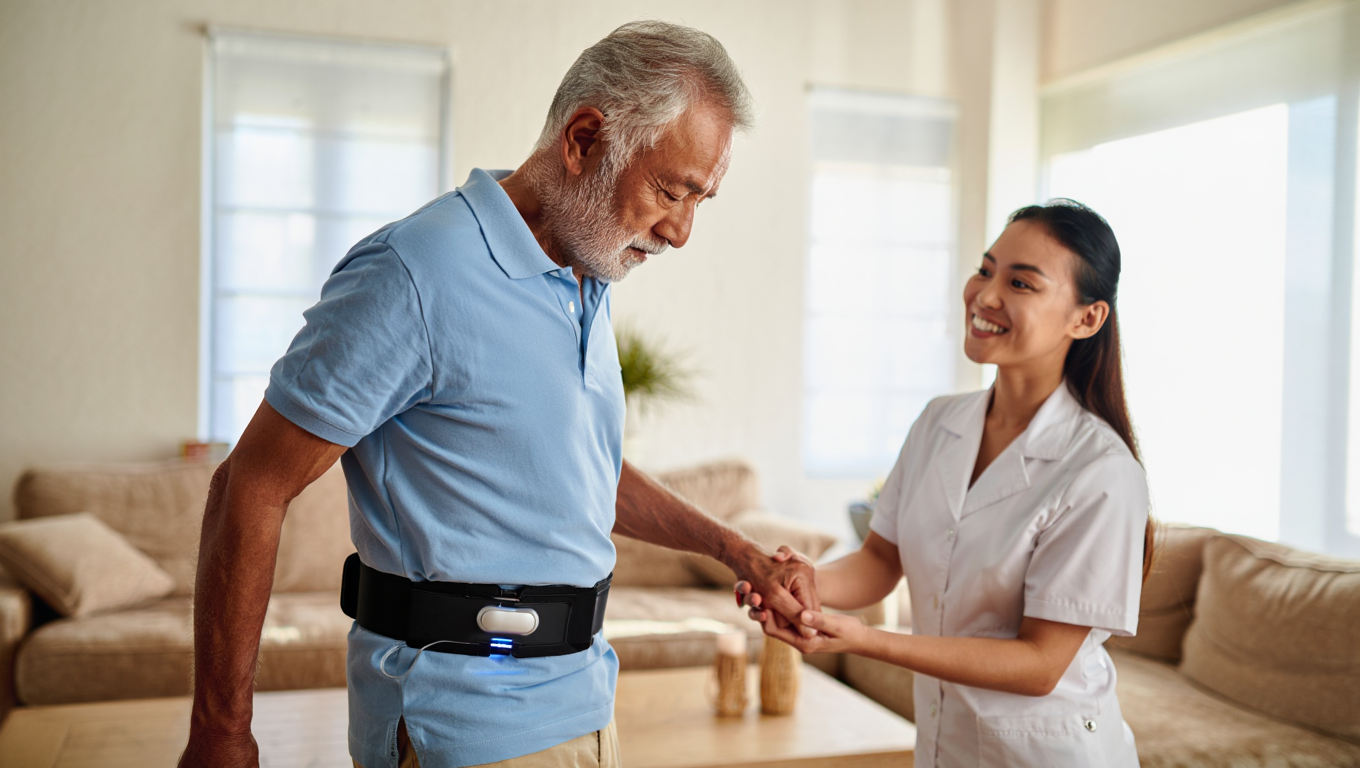Parkinson’s Fear of Falling: Best Exercises for Relief
Fear of falling is a major challenge for those with Parkinson’s disease, often triggered by falls or near-falls, leading to reduced mobility and independence. Over 60% of patients experience this fear, with 40% limiting activities as a result.
Physical therapy for Parkinson’s disease and targeted exercises for Parkinson’s disease are vital for overcoming these barriers. Just Walk, a home-based rehabilitation device, empowers patients with the
best exercises for Parkinson’s to improve gait, balance, and confidence safely at home.
What is Fear of Falling in Parkinson’s Disease?
Fear of falling in Parkinson’s stems from:
- Postural instability, disrupting balance and posture.
- Freezing of gait (FOG), sudden stops during walking, especially in tight spaces.
- Shuffling gait and bradykinesia (slow movement).
- Previous falls, causing anxiety and activity avoidance.
This fear creates a cycle of reduced mobility and weakened muscles, which Parkinson’s disease physical exercise can help break.
Why Fear of Falling Matters
Fear of falling affects patients, caregivers, and families, leading to social isolation, increased dependence, and worsened Parkinson’s symptoms. For caregivers, it means constant worry and support demands. Addressing this through best exercises for Parkinson’s and physical therapy for Parkinson’s disease restores mobility, reduces fall risks, and enhances quality of life for all involved.

Physical Therapy for Parkinson’s Disease: Rehabilitation Options
Effective Parkinson’s exercises combine physical and psychological approaches:
- Gait training with cues to reduce freezing of gait.
- Balance exercises, like Tai Chi, to improve stability.
- Strength training to enhance muscle power.
- Cognitive strategies to manage anxiety.
- Home safety modifications to minimize risks.
Clinical therapy is effective but often inaccessible due to logistical barriers. Home-based exercises for Parkinson’s disease, supported by Just Walk, offer a practical solution.
5 Exercises for Parkinson’s to Reduce Fear of Falling
The best exercises for Parkinson’s focus on mobility and confidence. Here are 5 exercises for Parkinson’s patients can practice at home:
- Cued Gait Training: Rhythmic cues improve walking rhythm and reduce freezing.
- Balance Drills: Weight-shifting or single-leg stands enhance stability.
- Resistive Leg Work: Strengthens muscles for better walking control.
- Stair Climbing Practice: Builds confidence in daily movements.
- Core Strengthening: Improves posture and reduces fall risk.
Just Walk facilitates these Parkinson’s exercises, making it the best exercise for Parkinson’s disease for home use.
Just Walk: Revolutionizing Parkinson’s Disease Physical Exercise
Just Walk is a lightweight (3 lb), mechanical, wearable device designed for physical therapy for Parkinson’s disease. Unlike canes or walkers, it’s a therapeutic tool for long-term motor retraining. Key features include:
- Cue-Assisted Walking: Reduces freezing with visual/auditory cues.
- Neuromuscular Training: Enhances stride, balance, and symmetry.
- Adjustable Resistance: Strengthens legs without overload.
- Portable Design: Supports daily exercises for Parkinson’s disease at home.
- Confidence Boost: Safe practice reduces fear of falling.
Why Just Walk Stands Out:
Just Walk excels over traditional aids by focusing on neuroplasticity-driven Parkinson’s exercises. Its portability and ease of use make it ideal for patients with Parkinson’s, stroke, or other neurological conditions. Caregivers benefit from its simplicity, enabling independent practice. Visit the Just Walk product page for videos and details.
To Sum Up
Fear of falling can limit life with Parkinson’s, but best exercises for Parkinson’s through physical therapy for Parkinson’s disease can restore mobility and confidence. Just Walk’s innovative design makes it the best exercise for Parkinson’s disease, enabling effective home-based Parkinson’s exercises. Start your journey to better mobility today with Just Walk.
Frequently Asked Questions (FAQ)
Q: What is the most effective therapy for Parkinson’s-related fear of falling?
A: A multidisciplinary approach combining gait and balance training, strength exercises, and confidence-building strategies is most effective. This often includes physical therapy and structured home-based rehabilitation. Devices like
Just Walk support regular gait practice, which improves mobility and reduces fear over time.
Q: Is Just Walk a walking aid like a cane or walker?
A: No. Just Walk is not a mobility aid. It is a home-based
gait rehabilitation device designed to help retrain walking patterns through structured sessions, promoting long-term motor improvement rather than short-term support.
Q: Can Just Walk help with freezing of gait?
A: Yes. Just Walk provides rhythmic cueing and repetitive walking practice, both shown to reduce the frequency and severity of freezing episodes in people with Parkinson’s.
Q: How does home training help reduce the fear of falling?
A: Regular, guided walking practice in a safe environment builds both physical ability and psychological confidence. Over time, this reduces the fear of falling and improves independence in daily life.
Q: What are the best Parkinson’s exercises to reduce fear of falling?
A: Exercises like cued gait training, balance drills, and strength building are highly effective. With tools like Just Walk, these can be practiced regularly at home to improve stability and reduce fall-related anxiety.
Sources
- Allen NE, Schwarzel AK, Canning CG. Recurrent falls in Parkinson’s disease: a systematic review. Parkinsonism & Related Disorders, 2013. PubMed Abstract
- Ghai S, Ghai I, Schmitz G, Effenberg AO. Effect of rhythmic auditory cueing on parkinsonian gait: A systematic review and meta-analysis. Scientific Reports, 2018.
Nature Article
Important
This article is for informational purposes only and is not a substitute for professional medical advice; always consult your doctor or physical therapist before starting any exercise or using any device.



